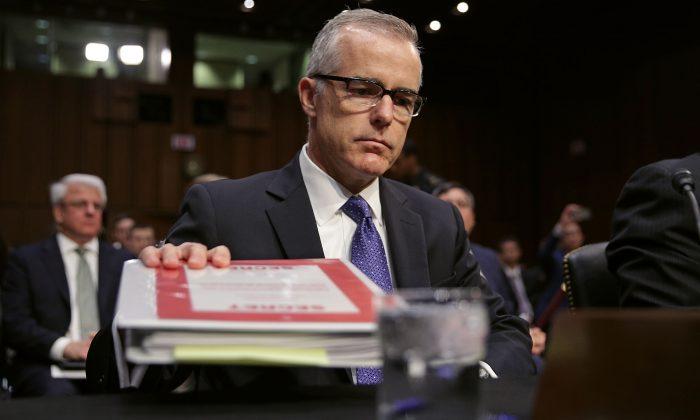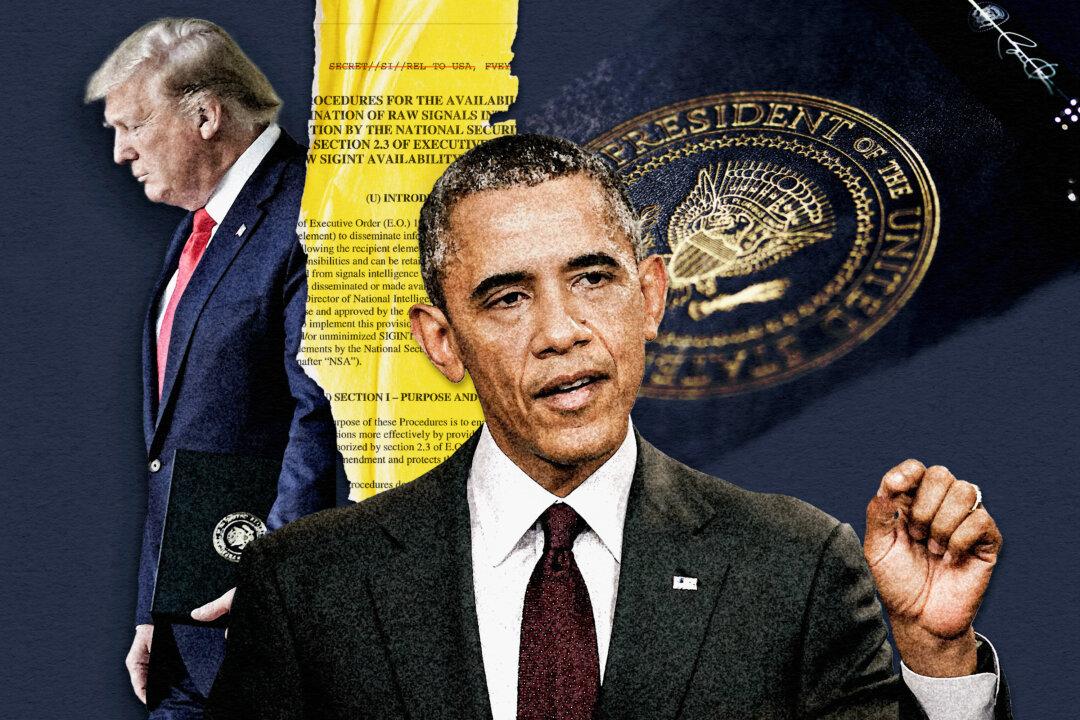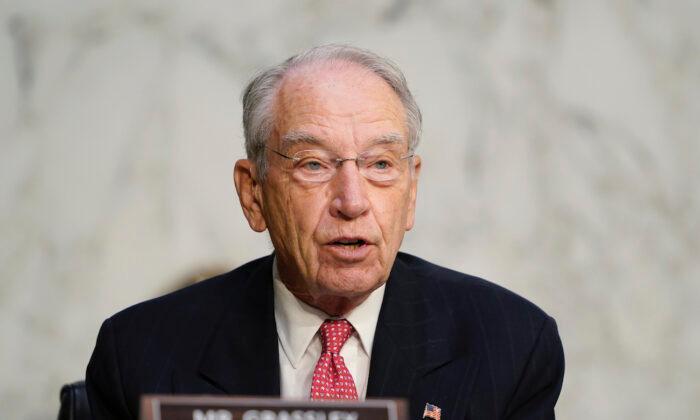Carter Page, a U.S. citizen who was a foreign policy adviser to the Trump presidential campaign in early 2016, was surveilled under Title I of the Foreign Intelligence Surveillance Act.
The FBI used the so-called Steele dossier—written by former MI6 agent Christopher Steele and paid for by the Clinton campaign and the Democratic National Committee—to portray Page as “an agent of a foreign power,” specifically Russia, to the Foreign Intelligence Surveillance Court (FISC).
FISA warrants on U.S. citizens must receive formal approval from the FISC, which requires that there be probable cause to believe the proposed target is a foreign power or an agent of a foreign power.
A FISA warrant allows for some of the most invasive methods of spying on an American citizen.
When asked by Congress in an Oct. 3, 2018, testimony about the FISA process, James Baker—the highest-ranking lawyer at the FBI at the time of the Page application—described a FISA warrant as allowing for “a set of highly intrusive surveillance techniques” that are used “to provide the FBI with foreign intelligence information.”
Baker, while acknowledging the inherent dangers of abuse of the FISA process, told investigators that it “is overseen closely by various elements of the government to make sure that it is being done for the right purposes.”
Several congressional testimonies reviewed for this article, however, reveal that FISA oversight may not be as robust as the American public has been led to believe.
Baker said that the FBI’s process of obtaining a Title I FISA warrant would typically originate from an FBI agent at a field office. That request would then be reviewed within the field office, by various supervisors within an escalating chain of command. As Baker stated in his testimony, there would also be a “legal scrub” at this point. From there, the request would entail interactions and approval from the Office of the General Counsel and FBI headquarters.
Once approval had been granted by the FBI, the request would be moved from the bureau to the Department of Justice’s Office of Intelligence, where the FISA request would undergo “a complete review at various levels” within the department.
Baker testified that once everyone agreed that they wanted the request to go forward, there would be “a signature process that the agencies go through” that included the director of the FBI or the deputy director. From there, the assistant attorney general for national security, the deputy attorney general, or the attorney general would sign the FISA prior to its presentation to the court.
FBI Sets Its Sights on Carter Page
According to Baker’s testimony, it appears that the FBI began to set its sights on former Trump campaign adviser Page in the summer of 2016. When asked how he had first gained knowledge of the FBI’s intention to pursue a FISA on Page, Baker testified that it came through his familiarity with the FBI’s investigation:FISAs Can Be Processed Orally
The FISA process is generally viewed as one that takes months of preparation before an application is actually presented to the FISA court. But according to Baker, the process could move very quickly and could even be done orally, if needed:Baker said the length of time varied with each application, noting, “It can take days, weeks, sometimes months to move a FISA through, depending -- it depends on the nature of the threat and the strength of the probable cause.”
FISA warrants are used to obtain foreign intelligence, but as Baker testified, FISAs can have a criminal component to them as well—as long as a high-ranking national security official signs off that a significant purpose of the FISA application is to obtain foreign intelligence.
“The line between what is criminal and what is intelligence sometimes becomes blurred and that was a big issue before 9/11 and even after 9/11, that has been sorted out basically now. But a significant purpose of the surveillance has to be for foreign intelligence purposes,” said Baker.
When asked what type of evidence might be present in a FISA application, Baker noted that it could come from a wide variety of lawful sources to establish probable cause and could include witness interviews and physical surveillance. Baker listed some additional sources:
“[Y]ou might have, confidential source information. You might have information from a foreign partner. You could have intercepts from some other intelligence agency that may have been provided to the FBI.”
Unusual Intervention by McCabe, Yates in FISA Application
Trisha Anderson, the principal deputy general counsel for the FBI and head of the bureau’s National Security and Cyber Law Branch, approved the application for a warrant to spy on Page before it went to FBI Director James Comey. During her Aug. 31 testimony, she described the FISA application process as being a linear path and noted there is a specific “system called FISAMS within the Bureau that tracks in a linear fashion all the approvals on a FISA.”Yet, despite the rigid description provided by Baker and Anderson, it appears the linearity process was not adhered to in the case of the Page FISA. According to Anderson, pre-approvals for the Page FISA were provided by both McCabe and Deputy Attorney General Sally Yates, before the FISA application was ever presented to her for review.
“[M]y boss and my boss’ boss had already reviewed and approved this application. And, in fact, the Deputy Attorney General, who had the authority to sign the application, to be the substantive approver on the FISA application itself, had approved the application. And that typically would not have been the case before I did that,” said Anderson.
Anderson told investigators that the Page FISA “was handled a little bit differently in that sense, in that it received very high-level review and approvals -- informal, oral approvals -- before it ever came to me for signature.”
The unusual preliminary review and approval from both McCabe and Yates appear to have had a substantial impact on the normal review process, leading other individuals like Anderson to believe that the Page FISA was more vetted than, perhaps, it really was. It is not known why McCabe and Yates both chose to insert themselves at an early stage into the Page FISA process.
Anderson told investigators that in general, as she approved applications, she was verifying that processes had been followed and legal sufficiency existed for the FISAs, but noted that she did so with “a great degree of deference to the many lawyers who have reviewed that application before me.”
But in the specific case of the Page FISA, Anderson viewed the situation as particularly unique, noting that “I wouldn’t view it as my role to second-guess that substantive approval that had already been given by the Deputy Director and by the Deputy Attorney General in this particular instance.”
15 to 20 FISAs Signed in 20 Minutes
The signing process by the FBI director appears to be more of an official act than any sort of actual review. Anderson testified that each day, the director might receive 15 to 20 FISAs to sign, with each containing large amounts of documentation.“[They’re] very thick. It’s not unusual for the Director to receive a stack this tall. I’m indicating about a foot and a half between my hands here, for the benefit of the reporter,” she said.
Anderson testified that the director was allotted 20 minutes in which to review the entirety of the day’s FISA applications—not 20 minutes per FISA.
No Fact Checking by Senior Staff
Even during normal circumstances, Anderson noted that she did not view it as her primary responsibility to provide any verification or fact-checking of the FISA applications. According to Anderson, FISAs would typically return from DOJ inspection with a cover note that “summarized the FISA,” and unless an issue had been identified by the cover note, she typically wouldn’t read the actual application “because of the time pressures involved and the sort of very-last-stop-in-the-process nature of the review.” Anderson also testified that the only way she would be aware of the legal predicate for probable cause would be through the DOJ cover note.Anderson told investigators that her direct supervisor, Baker, had personally read and reviewed the Page FISA, lending her additional confidence in the review process. However, according to Baker, he had only read the “factual section” relating to probable cause and had not read or reviewed any other section, including the Woods file.
The Woods file, which provides facts supporting the allegations made in a FISA application, is attached to every application and is provided by the originating FBI agent in each case.
Baker, during questioning as to why the FBI failed to disclose the political motivations of dossier author Steele to the FISC, testified that this fact should have been vetted during lower levels of preparation.
“So the people filing the FISA application and the people who checked the Woods file to verify that the way this works is that they would not have had any information that was derogatory about Source #1 at the time that this was submitted,” Baker said.
“That there might exist in the files of the FBI or in somebody’s memory some interaction that might be derogatory and that it didn’t make it into the files I don’t know that that happened or didn’t happen. That kind of thing in theory, in theory could happen. So, but the people responsible for this FISA should have believed that that was accurate at the time and should have had documentation to support that assertion.”
However, Sally Moyer, who was a unit chief at the Office of General Counsel, told lawmakers that only the originating agent and the supervisory special agent in the field actually look at the Woods file during the preparation of a FISA application:
…
Moyer told investigators that “the person that’s signing the application is relying on the individuals who have signed the Woods form that they have the Woods file.” Moyer stipulated that in some cases, the supervisory special agent at FBI headquarters who is signing off on an application might choose to review the Woods file, but that it was not done for the Page FISA.
Moyer said that routine compliance audits, known as accuracy reviews, are sometimes carried out by the DOJ’s Office of Intelligence and entail a review of nonspecific Woods files. However, she also noted that the Woods file relating to the Page FISA had not been reviewed or audited by anyone:
Flawed FISA Makes It Through the System
Baker told investigators that he felt it would be very difficult for the FBI or the DOJ to intentionally try to trick the FISC into issuing a FISA without sufficient evidence.“Such a thing wouldn’t make its way through the system because somebody would ferret that out it in the process. And I seriously doubt that it would make its way to the FISA court. Because the FBI doesn’t want to -- would not want to do that with respect to the director who is going to sign these things, nor to the Attorney General. And the Department of Justice would be very protective of the Attorney General and try to ferret out anything like that. And I think it would be kept away from the FISA court in the first instance,” Baker said.
Baker himself was unaware of some material facts. When he was told that high-ranking DOJ official Bruce Ohr—who had passed information from Steele and Fusion GPS co-founder Glenn Simpson to the FBI—had informed the FBI that there was the potential for bias, Baker seemed surprised, telling investigators, “I don’t recall ever hearing that before just right now.”
Notably, Baker testified that he was aware of Ohr’s interactions with Steele and the FBI, but told investigators “they weren’t something I focused on.” When pressed, he stated:
“I was aware that Bruce Ohr had some type of relationship with the source, and that somehow through that mechanism, the details of which I did not know, information was flowing to the FBI. From the source through Bruce to the FBI.”
Baker appeared to understand the sensitivity of the Page FISA, telling investigators at one point that he envisioned an interview like the one he was currently involved in:
“I anticipated being sitting here in rooms like this down the road, I seriously did, and I knew that it was -- I knew that it was sensitive. I knew that it would be controversial … It was connected to a candidate -- this person had connections to a candidate for the office of President of the United States. That alone was enough to make me worried about it and made me focus on it.”
No Hearings Held for Carter Page FISA
There is one final check in the FISA application process—the FISC itself. A federal judge would hear the FBI’s and DOJ’s arguments, questioning the process and the underlying evidence—except that never happened, and, apparently, rarely does. In response to a Freedom of Information Act lawsuit by Judicial Watch, the DOJ acknowledged that no hearings were held in relation to the Page FISA. The DOJ also noted that according to experts at the DOJ’s Office of Intelligence, this “is typical in proceedings before the FISC.”“These courses of action might include indicating to Court staff that he or she is prepared to approve the application without a hearing; indicating an inclination to impose conditions on the approval of the application; determining that additional information is needed about the application; or determining that a hearing would be appropriate before deciding whether to grant the application.”
Nor is the judge the only official that holds determination in this matter. According to the practices sent by Walton, the government also can request a hearing.
“In conjunction with its submission of a final application, the government has an opportunity to request a hearing, even if the judge did not otherwise intend to require one,” Walton wrote.
It’s worth reminding ourselves that the Page FISA was not just another run-of-the-mill surveillance warrant placed before the court by the intelligence community. Page had been a foreign policy adviser to the Trump campaign in the midst of a presidential election.
Given the obvious sensitivity of this particular FISA warrant, it seems surprising that no party thought it worthwhile to ask for a hearing—as provided for by FISA court practices.
Systematic Abuses in Accessing 702 Data
A damning 99-page unsealed ruling from the FISC, dated April 26, 2017, and issued by presiding Judge Rosemary Collyer, provided further insight into additional FISA abuse engaged in by the Intelligence Community in relation to Section 702 data and minimization procedures.Section 702 permits the government to surveil foreign persons located outside the United States for the purpose of acquiring foreign intelligence information. Minimization procedures are intended to protect any U.S. person’s information that is incidentally acquired in the course of Section 702 collection.
The FISA court found that the government had been engaging in a long pattern of significant abuses that were revealed to the court by then-National Security Agency Director Adm. Mike Rogers.
“On October 24, 2016, the government orally apprised the Court of significant non-compliance with the NSA’s minimization procedures involving queries of data acquired under Section 702 using U.S. person identifiers. The full scope of non-compliant querying practices had not been previously disclosed to the Court,” the FISC ruling read.
The court noted the government’s failure to previously notify the court of these issues, referring to the government’s actions as exhibiting an institutional “lack of candor” while emphasizing that “this is a very serious Fourth Amendment issue.”
The litany of abuses described in the April 26, 2017, ruling was shocking and detailed the use of private contractors by the FBI in relation to Section 702 data. The FBI was specifically singled out by the FISC numerous times in the ruling:
“The improper access previously afforded the contractors has been discontinued. The Court is nonetheless concerned about the FBI’s apparent disregard of minimization rules and whether the FBI may be engaging in similar disclosures of raw Section 702 information that have not been reported.”







